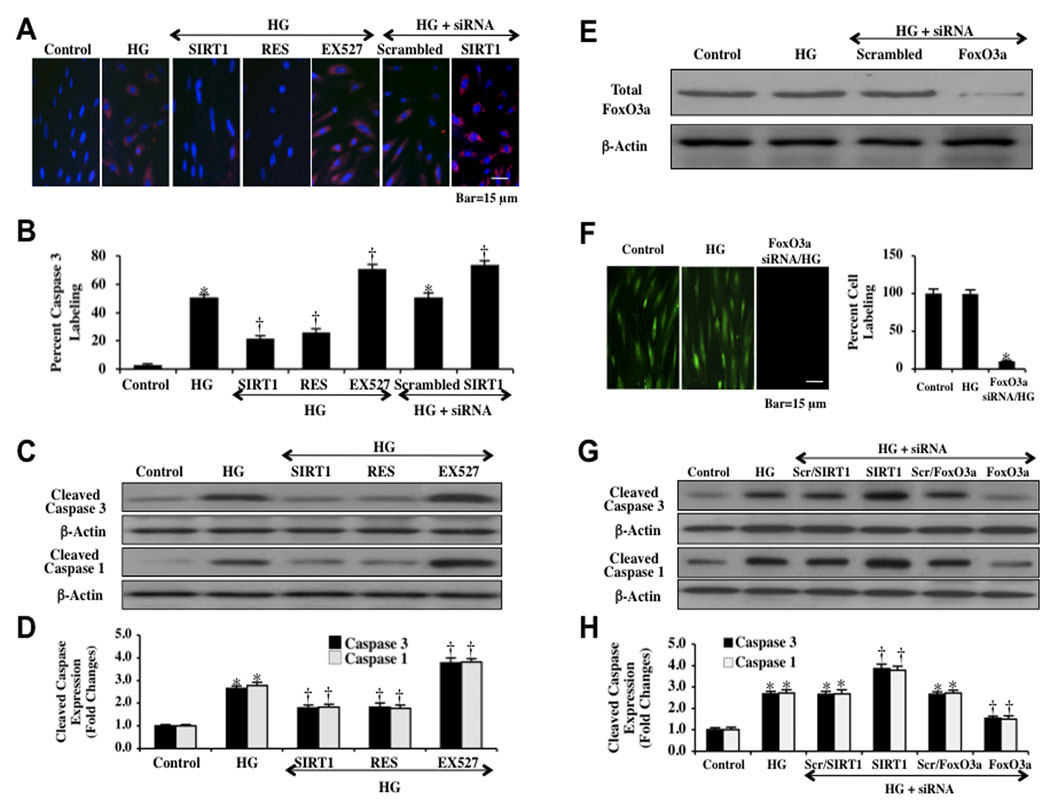Fig. (8). SIRT1 controls caspase 1 and caspase 3 activity during elevated D-glucose that employs FoxO3a.
In A, ECs were exposed to elevated D-glucose (HG = high glucose, 20 mM) and caspase 3 activation was determined 24 hours after elevated D-glucose exposure through immunocytochemistry with antibodies against cleaved active caspase 3 (17 kDa). Representative images illustrate active caspase 3 staining (red) in cells following elevated D-glucose, but cellular red staining is almost absent during activation of SIRT1 with SIRT1 protein (2 µM) or resveratrol (RES) (15 µM). Inhibition of SIRT1 activity with EX527 (2 µM) or during gene knockdown of SIRT1 significantly increased active caspase 3 expression to a greater degree in ECs that during elevated D-glucose alone, illustrating that SIRT1 activation was a robust modulator of caspase 3 activity. Non-specific scrambled siRNA did not eliminate caspase 3 activity during elevated D-glucose and both non-specific scrambled siRNA and transfection of SIRT1 siRNA alone did not alter caspase 3 activity in untreated control cells. In B, quantification of caspase 3 immunocytochemistry was performed using the public domain NIH Image program (http://rsb.info.nih.gov/nih-image) and demonstrates that elevated D-glucose (HG = high glucose, 20 mM) significantly increased the expression of cleaved (active) caspase 3 when compared to untreated control cells. Expression of cleaved (active) caspase 3 was significantly limited during SIRT1 activation (SIRT1 protein, RES), but potentiated to a greater degree with SIRT1 inhibition (EX527, SIRT1 siRNA) than during D-glucose exposure alone (*P<0.01 vs. untreated ECs = Control; †P<0.01 vs. HG). In C and G, EC protein extracts (50 µg/lane) were immunoblotted with anti-cleaved caspase 3 product (active caspase 3, 17 kDa) and with anti-cleaved caspase 1 product (active caspase 1, 20 kDa) at 12 hours following elevated D-glucose (HG = high glucose, 20 mM). Elevated D-glucose markedly increased cleaved caspase 3 and caspase 1 expression, but gene knockdown of FoxO3a with FoxO3a siRNA (siRNA) significantly blocked cleaved caspase 3 and caspase 1 expression 24 hours after elevated D-glucose. Non-specific scrambled siRNA did not eliminate caspase 3 or caspase 1 activities during elevated D-glucose and both non-specific scrambled siRNA and transfection of FoxO3a siRNA alone did not alter caspase 3 or caspase 1 activities in untreated control cells. In D and H, quantification of western band intensity was performed using the public domain NIH Image program (http://rsb.info.nih.gov/nih-image) and demonstrates that SIRT1 activation (SIRT1 protein, RES) prevents cleaved caspase 3 and caspase 1 expression 24 hours after elevated D-glucose exposure, but SIRT1 inhibition (EX527, SIRT1 siRNA) significantly increases cleaved caspase 3 and caspase 1 expression to a greater degree than with elevated D-glucose alone. Non-specific scrambled siRNA did not reduce cleaved caspase 3 or caspase 1 expression during elevated D-glucose (*P<0.01 vs. untreated ECs = Control; †P<0.01 vs. HG). SIRT1 siRNA alone in untreated control cells was not toxic. Each data point represents the mean and SEM from 6 experiments. In E, EC protein extracts (50 µg/lane) were immunoblotted with anti-total FoxO3a (FoxO3a) at 24 hours following elevated D-glucose (HG = high glucose, 20 mM). Gene knockdown of FoxO3a was performed with transfection of FoxO3a siRNA (siRNA). FoxO3a siRNA significantly reduced expression of FoxO3a protein in ECs following elevated D-glucose (HG = high glucose, 20 mM). Non-specific scrambled siRNA did not significantly alter total FoxO3a expression during elevated D-glucose. In F, transfection of siRNA against FoxO3a was performed in ECs and the expression of total FoxO3a protein was assessed by immunofluorescence. In ECs with FoxO3a gene knockdown, no significant expression of FoxO3a protein is present (*P<0.01 vs. untreated ECs = Control or HG). In G and H, gene knockdown of FoxO3a with FoxO3a siRNA (siRNA) significantly blocks cleaved (active) caspase 3 and caspase 1 activities 24 hours after elevated D-glucose exposure (HG = high glucose, 20 mM). FoxO3a siRNA alone and non-specific scrambled siRNA were not toxic. In addition, nonspecific scrambled siRNA did not change caspase 1 and caspase 3 activities when compared to elevated D-glucose alone (*P<0.01 vs. untreated ECs = Control; †P<0.01 vs. HG). Each data point represents the mean and SEM from 6 experiments.

